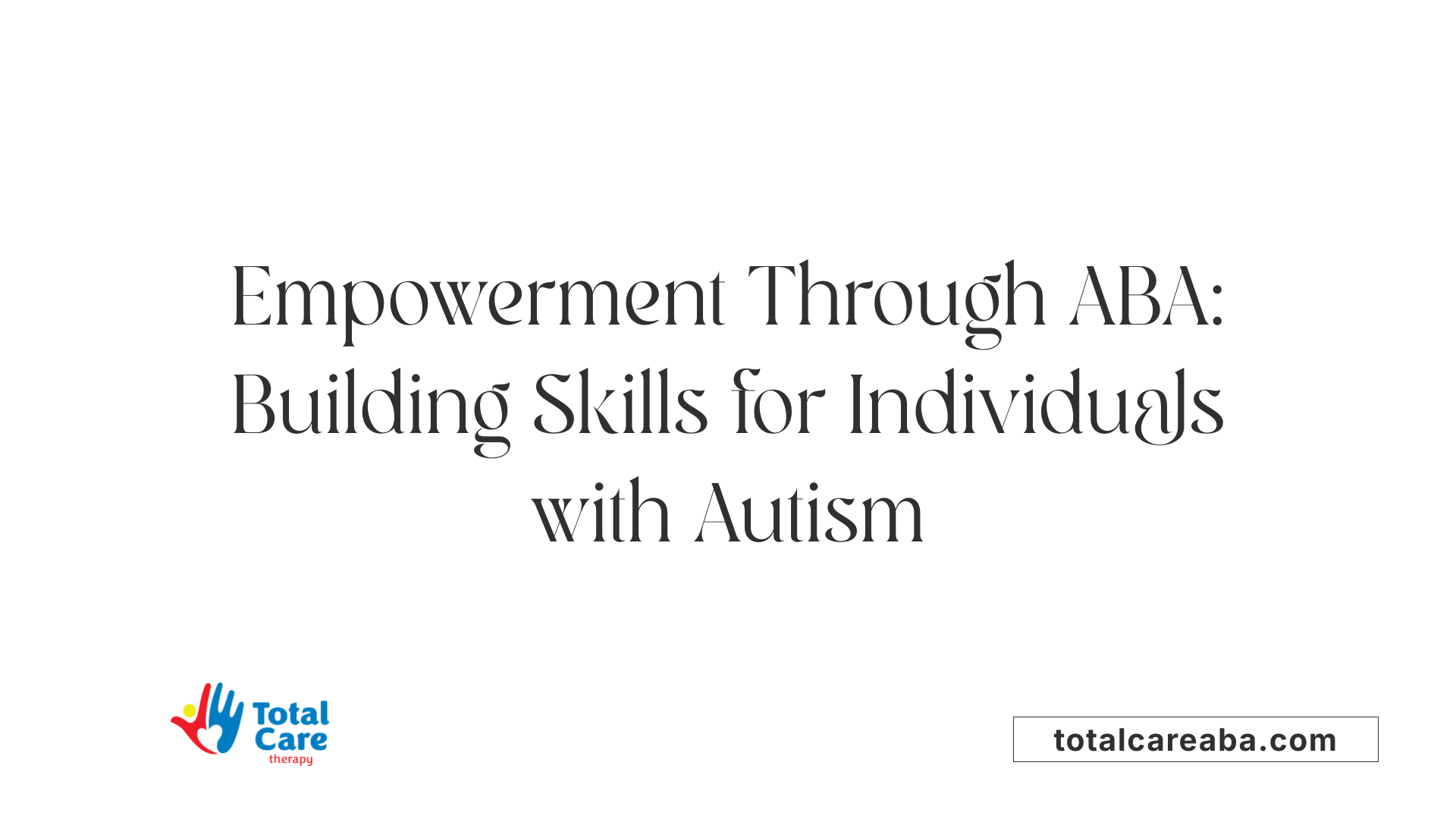Building ABA Therapy Skills
Enhancing Lives Through Applied Behavior Analysis
Building ABA Therapy Skills
Introduction to ABA Therapy
Applied Behavior Analysis (ABA) therapy has long been recognized as a leading method for supporting individuals with Autism Spectrum Disorder (ASD) and other developmental disabilities. By employing a scientific approach to behavior and learning, ABA provides a framework for teaching essential skills and improving quality of life. This article delves into the strategies and principles that power ABA therapy, shedding light on its practical applications, effectiveness, and the critical role of caregivers in the therapeutic process.
Core Techniques in ABA Therapy

What techniques are used in ABA therapy?
ABA therapy employs a variety of techniques to improve behaviors in individuals, especially children with Autism Spectrum Disorder (ASD). Here are some essential methods:
Positive Reinforcement: This foundational strategy rewards desirable behaviors, increasing their likelihood of being repeated. It’s a motivating factor in skill acquisition.
Discrete Trial Training (DTT): DTT breaks down complex skills into manageable steps, providing opportunities for positive reinforcement after each correct response. This method is particularly effective for teaching new behaviors.
Functional Communication Training (FCT): FCT is aimed at replacing challenging behaviors with more appropriate communication strategies, thus enhancing social interactions.
Modeling: In this technique, therapists demonstrate desired behaviors for children to imitate, fostering skill development through observation. It is useful in teaching social skills and effective communication.
Prompting: Various forms of prompting, such as verbal cues or physical guidance, support learners in executing tasks. These prompts are gradually faded to encourage independence.
Additional Techniques
Other valuable strategies include Extinction Techniques, aimed at reducing unwanted behaviors by discontinuing their reinforcement, and Natural Environment Teaching (NET), which allows learning to occur in real-life contexts, promoting better engagement.
Understanding these methods paves the way for effective, individualized interventions in ABA therapy, ensuring the best outcomes for each child.
Empowering Individuals with Autism Through ABA

How does ABA therapy support individuals with autism in developing skills?
ABA therapy supports individuals with autism by utilizing evidence-based practices to enhance their communication, social, and daily living skills. This structured approach starts by breaking down complex tasks into manageable steps. Positive reinforcement plays a key role, motivating individuals to repeat desired behaviors.
Customized treatment plans are developed by Board Certified Behavior Analysts (BCBAs), ensuring that each program is tailored to meet the unique strengths and challenges of individuals. This personalization is crucial for effective learning and meaningful progress.
Through consistent interventions such as Discrete Trial Training (DTT) and Natural Environment Teaching (NET), individuals learn not just to communicate but also to engage socially and interact in various settings. For example, DTT methodically breaks skills into smaller, achievable units, while NET applies learning in more natural circumstances, enhancing the relevancy of skills taught.
Here's a breakdown of some key skills targeted in ABA therapy:
| Skill Type | Areas Addressed | Technique Used |
|---|---|---|
| Communication Skills | Verbal language, nonverbal cues, social pragmatics | Modeling, prompting, reinforcement |
| Social Interaction | Initiating conversations, understanding norms, building friendships | Pivotal Response Training, Social Reinforcement |
| Daily Living Skills | Self-care routines, dressing, meal preparation | Task analysis, positive reinforcement |
| Customized Treatment | Individualized goals based on assessments | Data collection, analysis, and adjustments |
Overall, ABA therapy fosters greater independence, significantly improving the quality of life for individuals with autism by equipping them with the essential skills needed for daily interactions and maintaining adaptive behaviors.
The Seven Dimensions of ABA

What are the 7 dimensions of ABA that define successful programs?
The 7 dimensions of Applied Behavior Analysis (ABA) define successful programs in several critical ways:
| Dimension | Description | Importance |
|---|---|---|
| Applied | Focuses on socially significant behaviors that directly impact the individual's life, ensuring practical relevance. | Ensures that interventions address real-world issues faced by individuals, making therapy meaningful and impactful. |
| Behavioral | Emphasizes the need to target observable and measurable behaviors for effective tracking and evaluation. | Allows for clear assessment of interventions, ensuring progress can be effectively monitored and strategies adjusted based on data. |
| Analytic | Ensures that interventions are evidence-based and data-driven, confirming relationships between behaviors and environmental variables. | Demonstrates that changes in behavior can indeed be attributed to the applied strategies, fostering trust in the process. |
| Technological | Requires that procedures be clearly articulated and replicable, allowing consistency across different practitioners. | Promotes standardized practices within the field, reducing variations in implementation that could affect outcomes. |
| Conceptually Systematic | All interventions must be grounded in established behavioral principles. | Ensures that practices are not only effective but also reflect sound behavioral science, reinforcing the integrity of the approaches used. |
| Effective | Assesses whether interventions lead to meaningful behavior change and improvements in the individual's skill set. | Focuses on measuring positive outcomes that matter in the daily lives of individuals, ensuring that therapy is beneficial. |
| Generality | Ensures that learned skills can be applied across various settings and remain durable over time. | This dimension is crucial for helping individuals maintain and use learned behaviors in different aspects of their lives, promoting long-term success. |
Implementing Behavioral Skills Training

What is Behavioral Skills Training in ABA?
Behavioral Skills Training (BST) is an evidence-based approach used in applied behavior analysis (ABA) designed to teach new skills through a systematic method. It consists of four key components: instruction, modeling, rehearsal, and feedback, which together create an effective framework for skill acquisition.
Instruction
In the instruction phase, the learner is provided with clear, concise information about the desired skill or behavior. This lays the foundation for understanding what is expected and why it is essential. Trainers often break down skills into manageable parts, making it easier for learners to grasp the concepts before attempting to practice them.
Modeling
The modeling phase involves demonstrating the skill or behavior for the learner. A trainer or peer performs the desired behavior while the learner observes. This visual representation is crucial as it allows learners to see exactly how the skill is executed, which enhances their learning experience.
Rehearsal
During the rehearsal phase, the learner gets the opportunity to practice the skill. This hands-on experience allows them to apply what they learned during the instruction and modeling phases. The goal here is for learners to gain confidence as they perform the behavior, with support provided as needed.
Feedback
Finally, the feedback phase involves giving the learner constructive feedback on their performance. Specific praise for correct actions reinforces the learning, while gentle corrections help guide improvements. Positive reinforcement during this stage is crucial as it encourages continued practice and mastery of the skill.
| Component | Description | Importance |
|---|---|---|
| Instruction | Clear explanation of the skill | Establishes understanding |
| Modeling | Demonstration of the skill | Provides a visual guide |
| Rehearsal | Practice of the skill by the learner | Builds confidence and ability |
| Feedback | Constructive responses to performance | Encourages mastery |
Research highlights BST's flexibility and efficiency in teaching a wide range of behaviors quickly while ensuring high retention and application rates. Additionally, ethical considerations are integral to BST, emphasizing informed consent, trainer competence, and cultural sensitivity.
Misunderstanding ABA Therapy: Addressing Common Myths

What are some common misconceptions about ABA therapy?
Applied Behavior Analysis (ABA) therapy often faces misconceptions that can cloud its perceived effectiveness and applicability. One notable myth is that ABA is exclusively for individuals with autism. In reality, ABA strategies can benefit a wide array of disabilities and behavioral challenges, making it a versatile approach in various contexts.
Critics sometimes highlight the history of ABA, noting punitive methods used in early practice. However, modern ABA strongly emphasizes positive reinforcement and focuses on skill development in engaging environments that resonate with individuals. This shift has resulted in a therapy that not only nurtures but also empowers clients.
Another misconception is the belief that ABA aims to make autistic individuals conform to neurotypical behaviors. On the contrary, proponents argue that ABA encourages individuality and independence by working with a child’s existing strengths, rather than against them. This personalized approach ensures that therapy is adaptive to each learner's needs.
Additionally, some perceive ABA as a rigid program that lacks flexibility. To the contrary, effective ABA programs are tailored to the person’s unique needs and can be implemented in diverse settings—be it home, school, or community. This adaptability enhances the effectiveness of interventions, allowing skills learned in therapy to be generalized in daily life.
In summary, numerous studies support ABA as an evidence-based best practice. It has been shown to significantly enhance outcomes across developmental and behavioral issues—heralding a much broader scope and potential than often recognized.
Essential Qualities of an Effective ABA Therapist
What skills are essential for a successful ABA therapist?
To be a successful ABA therapist, several essential skills must be developed and honed. One of the most important is data interpretation. Therapists need to gather, analyze, and use behavioral data to inform and tailor treatment plans effectively. This ensures that the interventions are based on solid evidence, enabling targeted strategies that cater to individual needs.
Second, communication skills play a crucial role. Therapists must clearly convey behavioral concepts and instructions to both clients and their families. This opens pathways of understanding and trust, essential for a collaborative approach to therapy.
Empathy is another vital component. An effective therapist must approach sessions with empathy and patience, especially when working with children on the autism spectrum. Creating a nurturing and understanding environment greatly contributes to the therapeutic relationship and enhances learning outcomes.
Additionally, problem-solving skills are paramount. Challenges can often arise during therapy sessions, so therapists should be quick and adaptable in addressing these issues. This flexibility allows them to modify interventions as needed to maintain progress.
Finally, a commitment to lifelong learning is essential. The field of ABA is continuously evolving, and staying updated on current approaches ensures the best outcomes for clients. Collaboration with families and other professionals further enriches the effectiveness of therapies, promoting a well-rounded and comprehensive support system for individuals with autism spectrum disorder.
Exploring the Criticisms of ABA Therapy
Are there negative experiences associated with ABA therapy?
While many individuals find Applied Behavior Analysis (ABA) therapy beneficial, significant concerns exist regarding negative experiences associated with it. Critics argue that historical practices included not only positive reinforcements but also punishments, which can be harmful and have lasting effects. Some detractors believe that ABA tends to focus on making autistic individuals conform to neurotypical standards, potentially disregarding their unique identities and needs.
Reports have highlighted that ABA could lead to long-term negative outcomes. These can include PTSD symptoms, emotional distress, and in the most severe cases, suicidal ideation among those who have undergone extensive therapy. If ABA excessively targets behaviors like stimming, which are often coping mechanisms for many autistic individuals, it might exacerbate rather than alleviate personal challenges.
Furthermore, cases of abuse and trauma related to improper implementation of ABA techniques have been documented. This leads many to caution parents to carefully consider the potential risks and review the specific methodologies employed in therapy. It's essential to recognize that ABA therapy may not be suitable for every child, and as with any therapeutic approach, ensuring respect for the individual’s well-being and preferences is crucial.
The Role of Play in ABA Therapy
Structured Play
Structured play is a vital component of Applied Behavior Analysis (ABA) therapy. It provides a framework for teaching crucial skills within a controlled environment. Using methodologies like Discrete Trial Training (DTT), therapists break down play activities into manageable steps. For instance, rather than simply encouraging a child to engage in a game, they may teach turn-taking and sharing step-by-step. By using positive reinforcement, children learn to associate successful play with rewarding experiences, thereby enhancing skill acquisition.
Stages of Play
Children with autism often progress through various stages of play: solitary, onlooker, parallel, and interactive. Therapists utilize these stages to facilitate skill development. Early stages allow for individual exploration, while later stages encourage social interaction.
Skill Development
Engaging in directed play activities can significantly improve essential skills. Children learn to communicate their needs, develop problem-solving abilities, and enhance social interactions through guided play opportunities. Techniques such as Natural Environment Teaching (NET) also encourage spontaneous play and social exchanges in less structured settings, reinforcing learning in real-world contexts. Overall, integrating play into ABA facilitates cognitive growth and encourages social engagement, making it a fundamental aspect of therapy.
Benefits of Parental Involvement in ABA
What is Parent-Implemented Intervention (PII)?
Parent-Implemented Intervention (PII) is an essential component of Applied Behavior Analysis (ABA) that enables parents to actively participate in their child's therapy. This approach allows parents to reinforce skills learned during therapy sessions in the comfort of their home. By engaging in PII, parents can help their children practice new skills, fostering quicker mastery of these behaviors.
Why is Home Reinforcement Important?
Home reinforcement plays a critical role in sustaining the progress achieved during therapy. When parents consistently apply reinforcement strategies at home, they create a supportive learning environment that encourages their children's growth across various settings. This continuity is particularly effective as it allows children to generalize skills, ensuring they can apply what they've learned in everyday circumstances.
How Does Skills Generalization Work?
The ultimate goal of ABA therapy is for children to generalize skills from therapy contexts to real-life situations. Parental involvement significantly facilitates this process. When parents reinforce skills in different settings—like at home, in the community, or during playdates—it helps children understand how to use these skills naturally. This ability to transfer learned behaviors into various contexts is vital for promoting independence and confidence in social interactions and daily activities.
Advancing ABA Skills Through Play
Natural Environment Teaching (NET)
Natural Environment Teaching (NET) leverages everyday experiences to ensure learning occurs in familiar settings. This strategy enhances engagement and facilitates the transfer of skills learned in structured environments to real-world contexts. By integrating skill acquisition into natural play scenarios, children with autism find opportunities to practice and generalize their skills effectively.
Pivotal Response Training (PRT)
Pivotal Response Training (PRT) focuses on a child’s motivations by tailoring play activities to their interests. This method increases the child’s engagement, fostering enthusiasm and learning through naturally occurring opportunities for interaction. By emphasizing pivotal behaviors, such as motivation and social initiations, PRT enhances overall skill development in meaningful ways.
Play in Skill Development
Play serves as a foundation for developing essential life skills. In ABA therapy, structured play activities break down social interactions and other complex skills into manageable steps. Techniques like Discrete Trial Training (DTT) and modeling help teach communication and social skills through playful engagement. Supporting play environments stimulate children's exploration, creativity, and social interactions, which are vital for holistic development.
Concluding Thoughts
In conclusion, ABA therapy remains a cornerstone in the field of learning and behavior modification, especially for individuals with autism. By employing a broad range of evidence-based techniques, ABA fosters meaningful improvements in communication, social interaction, and independence. While it's crucial to address both the benefits and criticisms alongside tailoring the approach to fit individual needs, the collaborative effort between therapists and caregivers ensures that the therapeutic goals are met effectively. As ABA continues to evolve, informed participation from all stakeholders, including parents and therapists, will further enhance the outcomes for those who rely on these fundamental interventions for skill development.
References
- Applied Behavior Analysis (ABA) - Autism Speaks
- Building ABA Therapy Skills
- How ABA Therapy Helps Build Daily Living Skills
- 5 Essential Skills to Become an ABA Therapy Specialist Online
- What Skills Can Your Child Learn in ABA Therapy?
- ABA Therapy for Enhancing Autism Skills - Yellow Bus ABA
- ABA Therapy Techniques That Help Children With Autism
- ABA Therapy Techniques for Developing Daily Skills








